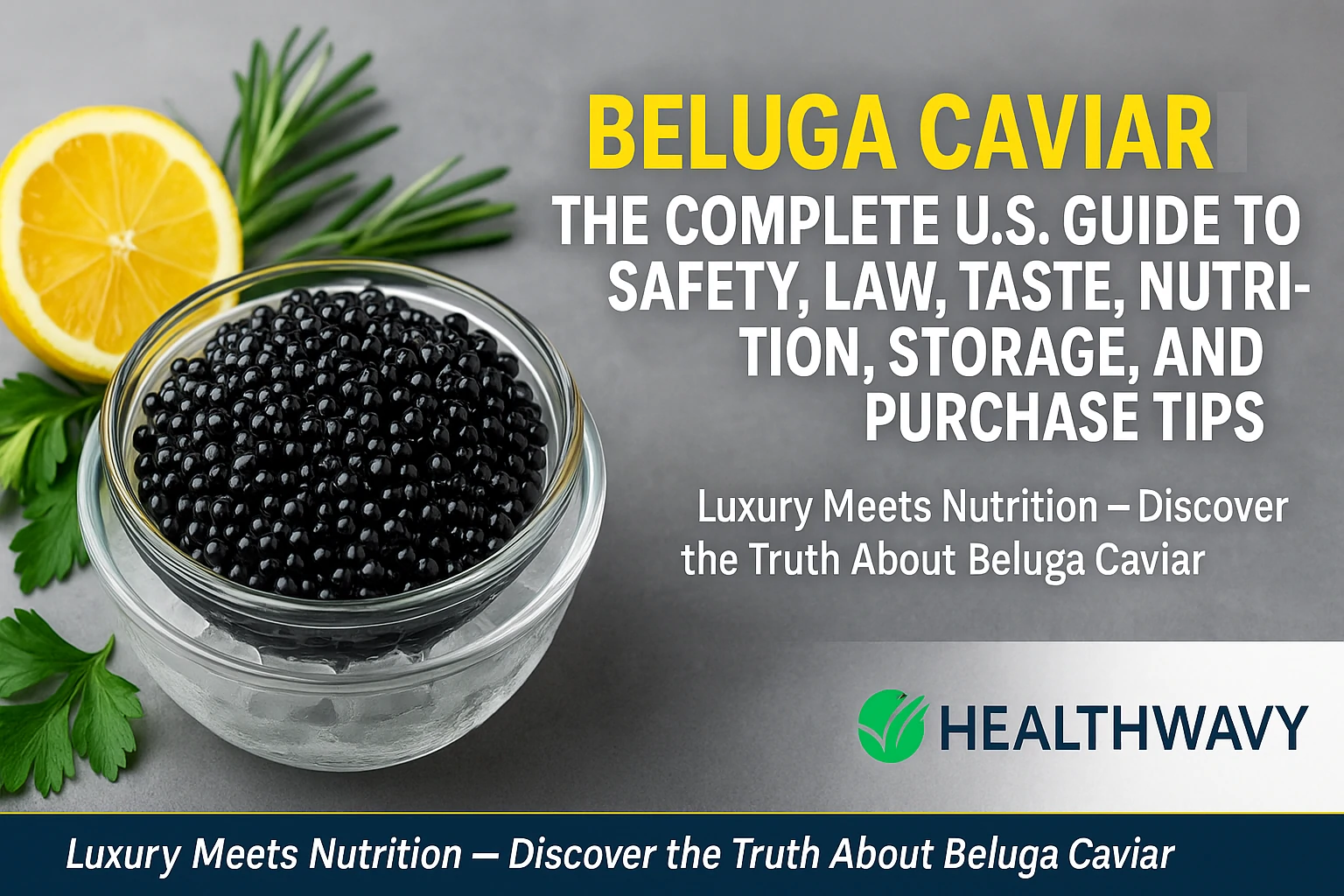Beluga caviar has a strong reputation around the world. It comes from the Huso huso sturgeon, one of the oldest fish still alive today. The eggs are large, glossy, and rich in flavor. Each spoonful brings a smooth texture and a clean finish. Many people call it the king of caviar.
In the United States, beluga caviar is rare and expensive. Strict laws protect the beluga sturgeon, which is an endangered species. Legal caviar comes only from approved farms. Buyers must follow U.S. rules to stay safe and avoid fines. This guide explains those rules in plain English.
This article helps you understand the full story. You will learn how to spot real beluga caviar, how to store it, how to serve it, and how to tell it apart from other types. You will also learn why taste, texture, and salt level matter. If you want to buy caviar, serve it to guests, or gift it during the holidays, this guide gives you clear steps.
You do not need to be a food expert. You just need the right facts. Keep reading to explore the world of beluga caviar the safe and smart way.
What Makes Beluga Caviar Legal, Safe, and Worth the Taste
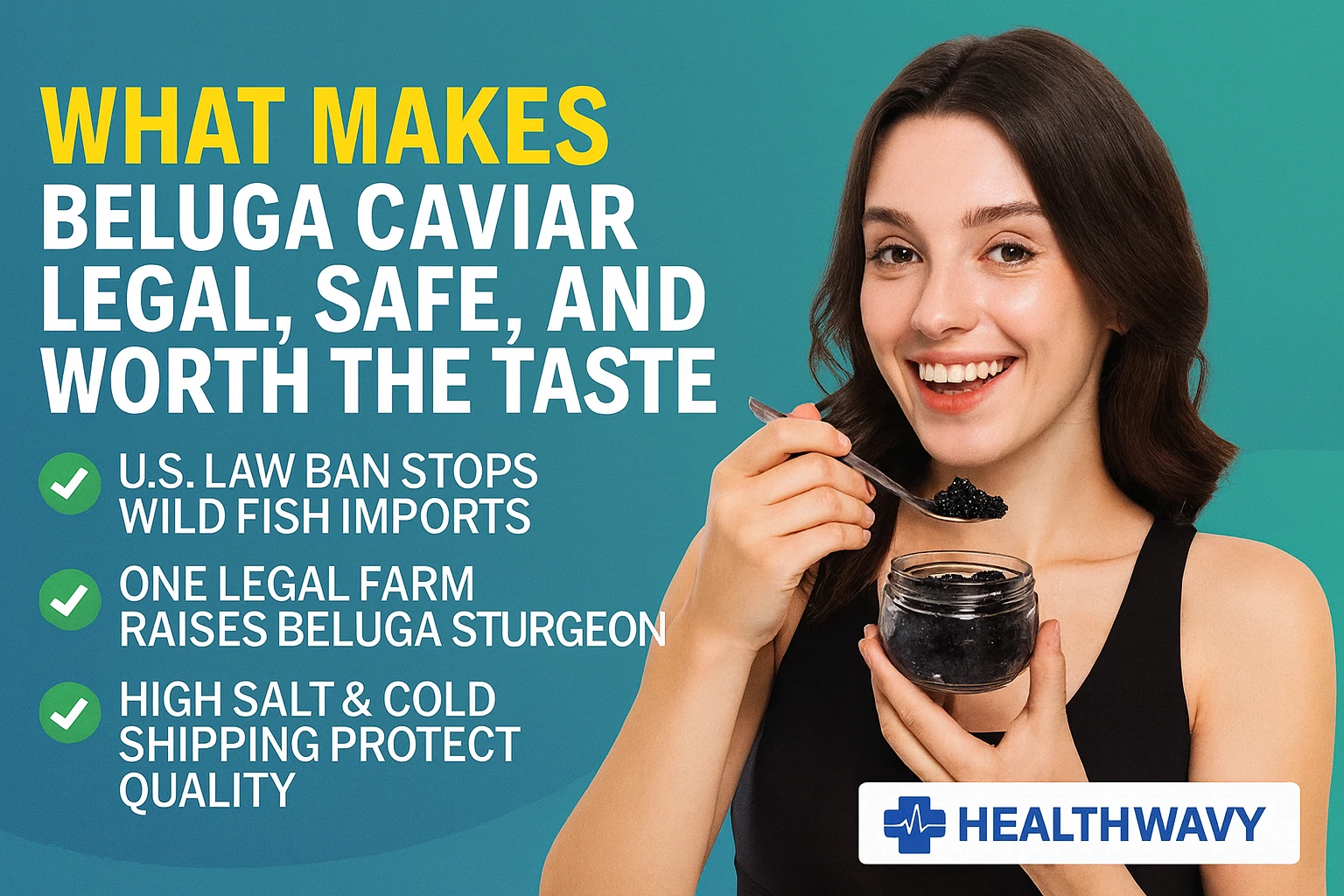
Beluga caviar is known for its smooth taste and large pearls. Each egg gives a soft pop in the mouth. The flavor feels mild and clean. Good caviar has light salt, soft shine, and even texture.
Safety starts with the source. In the U.S., only one farm has permission to raise beluga sturgeon. It follows strict rules. Every tin must show the species name, batch code, and farm approval.
The law bans wild imports. This protects the beluga fish in nature. People who buy illegal caviar may face legal trouble. Real caviar must follow cold-chain rules. It must ship cold, stay cold, and arrive cold.
Taste comes last, but it matters most. A true tin of beluga caviar offers a soft flavor that fades slowly. It pairs well with dry champagne or plain toast. It never tastes sharp or fishy.
Legal Status, Safety, and Smart Picks
In 2005, the U.S. banned the import of wild beluga caviar. This law protects the endangered Huso huso species. The rule is part of the Endangered Species Act. It stops foreign fish from entering the market.
Only one U.S. farm has legal approval to raise beluga sturgeon. That farm uses closed water systems and follows safety checks. Its caviar is the only legal source of beluga roe in the country.
Smart buyers look for three key signs:
- The label shows “Huso huso” clearly
- The batch code links the product to a legal farm
- The seller offers fast shipping with cold packs
Do not trust any brand that claims to sell “wild Caspian caviar.” That label breaks the law. Also avoid tins with no species name or vague terms like “premium black caviar.”
To explore another nutrient-rich food that balances flavor and health, check out The Ultimate Tahini Guide: Nutrition, Health Benefits, and Smart Ways to Use It Daily.
History, Types, Price, and Health Facts
Beluga caviar has a long past. It began in the Caspian Sea region. Rulers in Russia, Iran, and nearby areas served it during royal events. Wild sturgeon once filled the rivers. People caught the fish with ease. That time has ended.
Now, beluga sturgeon are rare in the wild. Dams, pollution, and overfishing nearly wiped them out. Today’s farms raise them in clean tanks. These tanks control water, light, and feed. The fish grow slow. Most do not produce eggs until they are 15 to 20 years old.
Types of caviar depend on the fish. Beluga eggs are the largest. Kaluga eggs are close in size. Osetra offers a nutty bite. Sevruga tastes saltier and comes in smaller pearls. White sturgeon gives smooth texture with mild flavor.
Beluga caviar costs $200 to $500 per ounce. Health facts show that it contains protein, omega-3 fats, and vitamins. It supports brain health and immune function. But the salt level is high, so keep the portion small.
Nutrition, Risks, and Safe Sources
One tablespoon of beluga caviar has 40 to 60 calories. It gives 4 to 6 grams of protein and 3 to 5 grams of fat. Most of the fat is healthy. You also get strong levels of vitamin B12, A, D, and E. Omega-3 fatty acids help with heart and brain health.
The biggest risk is high salt. One serving can have 250 to 400 mg of sodium. This may affect people with high blood pressure. Another risk comes from bad storage. Caviar must stay cold. Warm tins can spoil fast and grow harmful bacteria.
Safe sources follow the law. They label the species, show the batch code, and ship with cold packs. The best sellers answer questions and offer returns. They do not claim “wild” or “Caspian.” They give facts, not fluff.
Beluga Caviar vs Other Caviar: Taste, Texture, and Value
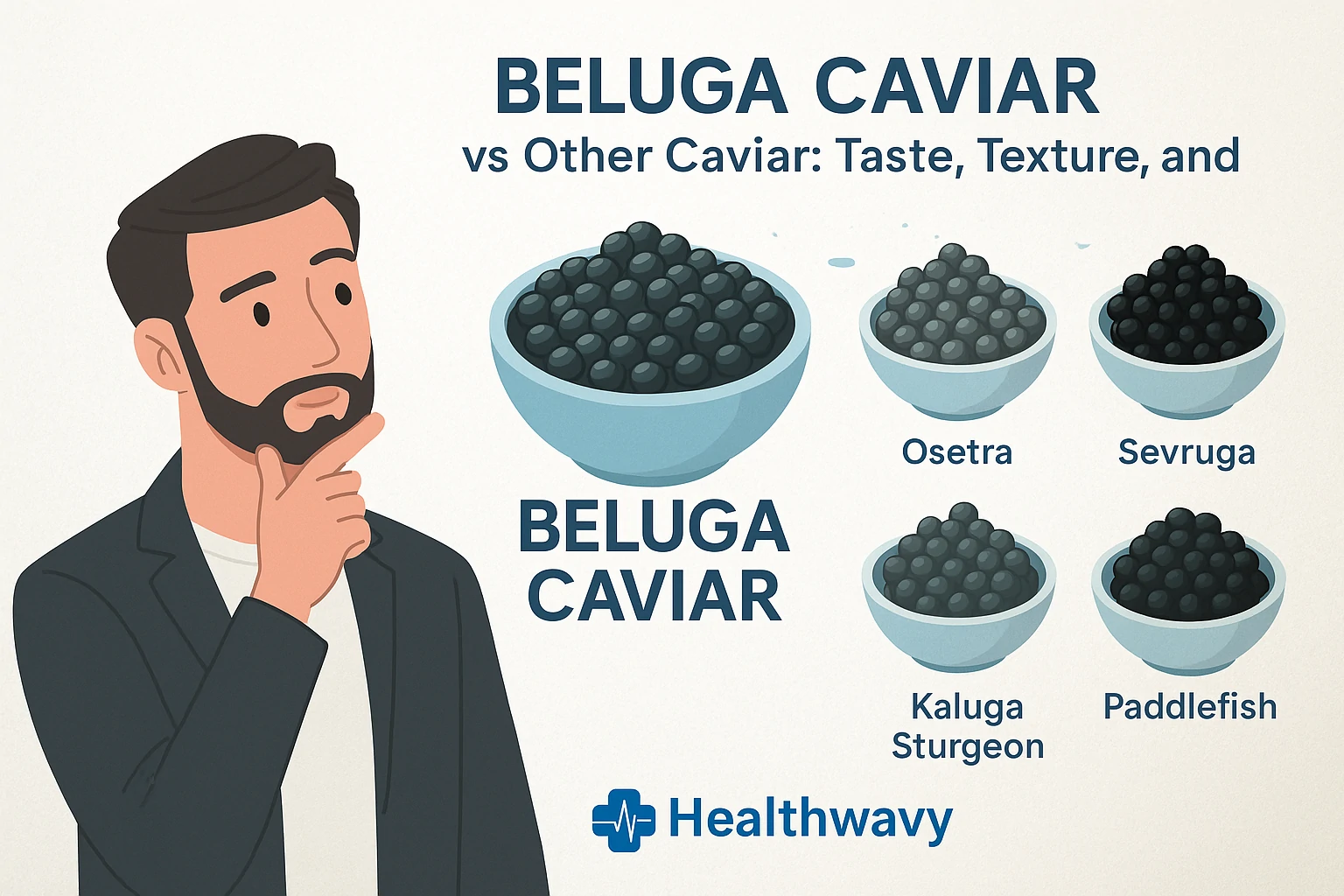
Not all caviar is the same. Beluga caviar stands out because of its size, smooth texture, and soft flavor. The pearls are large and light gray to deep black. They give a gentle pop in the mouth and leave a creamy finish. It feels refined and mild.
Other types offer different traits:
- Osetra has medium pearls and a firm texture. It gives a nutty, rich taste that many people enjoy.
- Sevruga has small pearls and a bold, salty flavor. It works well for those who like a sharp bite.
- Kaluga hybrid caviar is the closest to beluga in taste and size. It often costs less and follows U.S. law.
- White sturgeon caviar is farmed in California and gives a buttery, smooth taste with medium pearls.
- Paddlefish roe comes from a U.S. fish, not a sturgeon. It has an earthy tone and lower price.
If you want the most refined experience, beluga is the top choice. If you want good value with similar taste, Kaluga makes sense. For everyday meals, white sturgeon or paddlefish are solid picks.
How to Buy, Verify, and Store
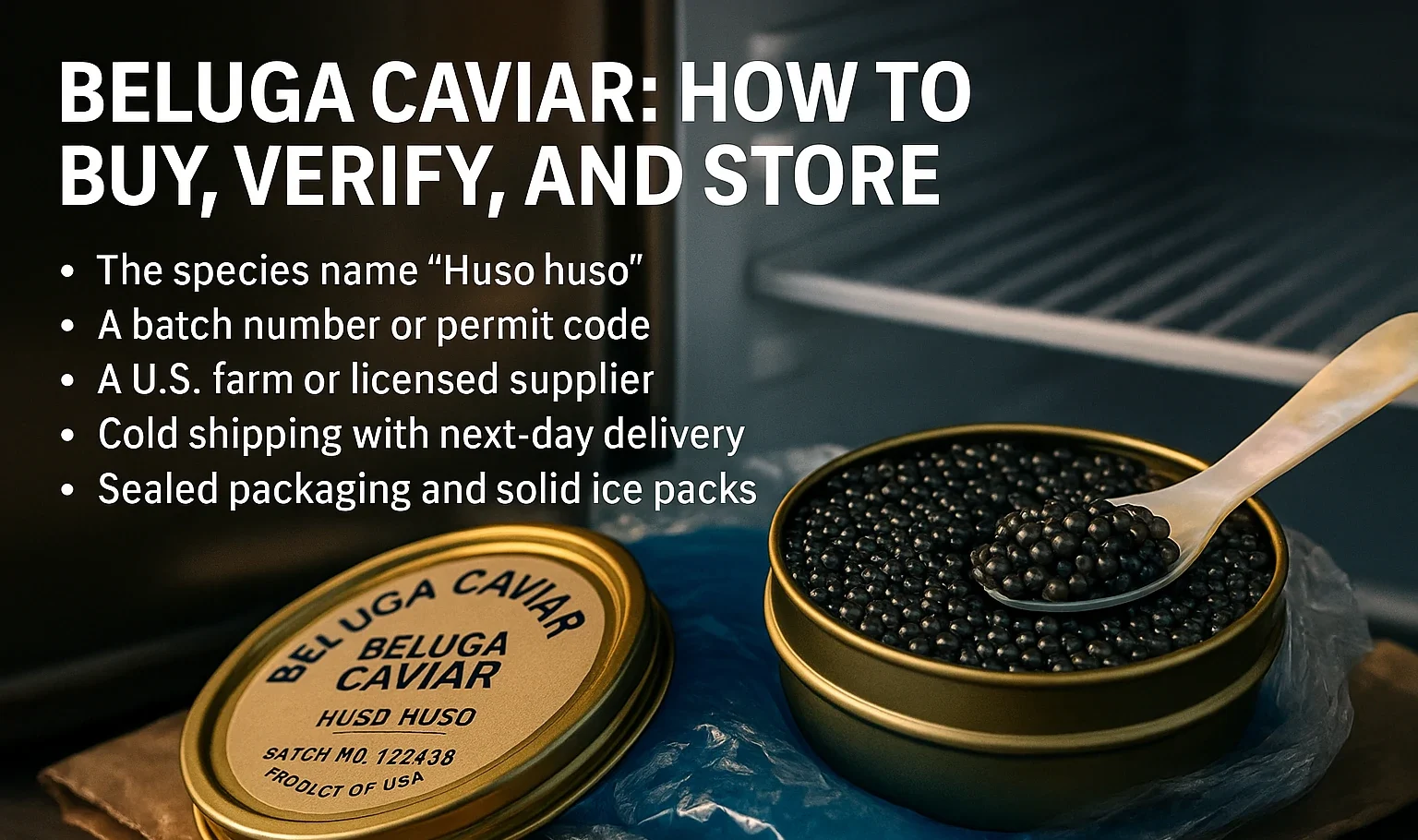
Buying beluga caviar in the U.S. requires care. You must choose the right seller and check the product details. Real tins will show:
- The species name “Huso huso”
- A batch number or permit code
- A U.S. farm or licensed supplier
- Cold shipping with next-day delivery
- Sealed packaging and solid ice packs
Once it arrives, inspect the tin. It should be cold and firm. The lid must not bulge. You should see a clear label with farm or lot info. Do not trust tins with no codes or vague wording like “premium black caviar.”
Store the tin in the coldest part of your fridge. The best range is 28°F to 32°F. Keep it closed until you plan to eat it. After opening, press plastic wrap against the surface and close the lid tight. Eat within 24 to 48 hours.
Pasteurized vs Raw, What You Must Know
Pasteurized caviar goes through light heat treatment. This process kills bacteria and helps the product last longer. The eggs become slightly firmer and less fragile. It is safe for pregnant people and those with weak immune systems.
Raw caviar has not been heated. It gives a fresher, smoother texture. The flavor is deeper and more delicate. But it spoils faster and must stay very cold. If raw caviar warms up, it becomes unsafe to eat.
Always check the label. Pasteurized tins often say so. Raw tins need faster delivery and more care. If you plan to host a party or send a gift, pasteurized may be safer. If you are doing a tasting at home, raw may offer more flavor.
Serving Tips, Pairings, and Etiquette
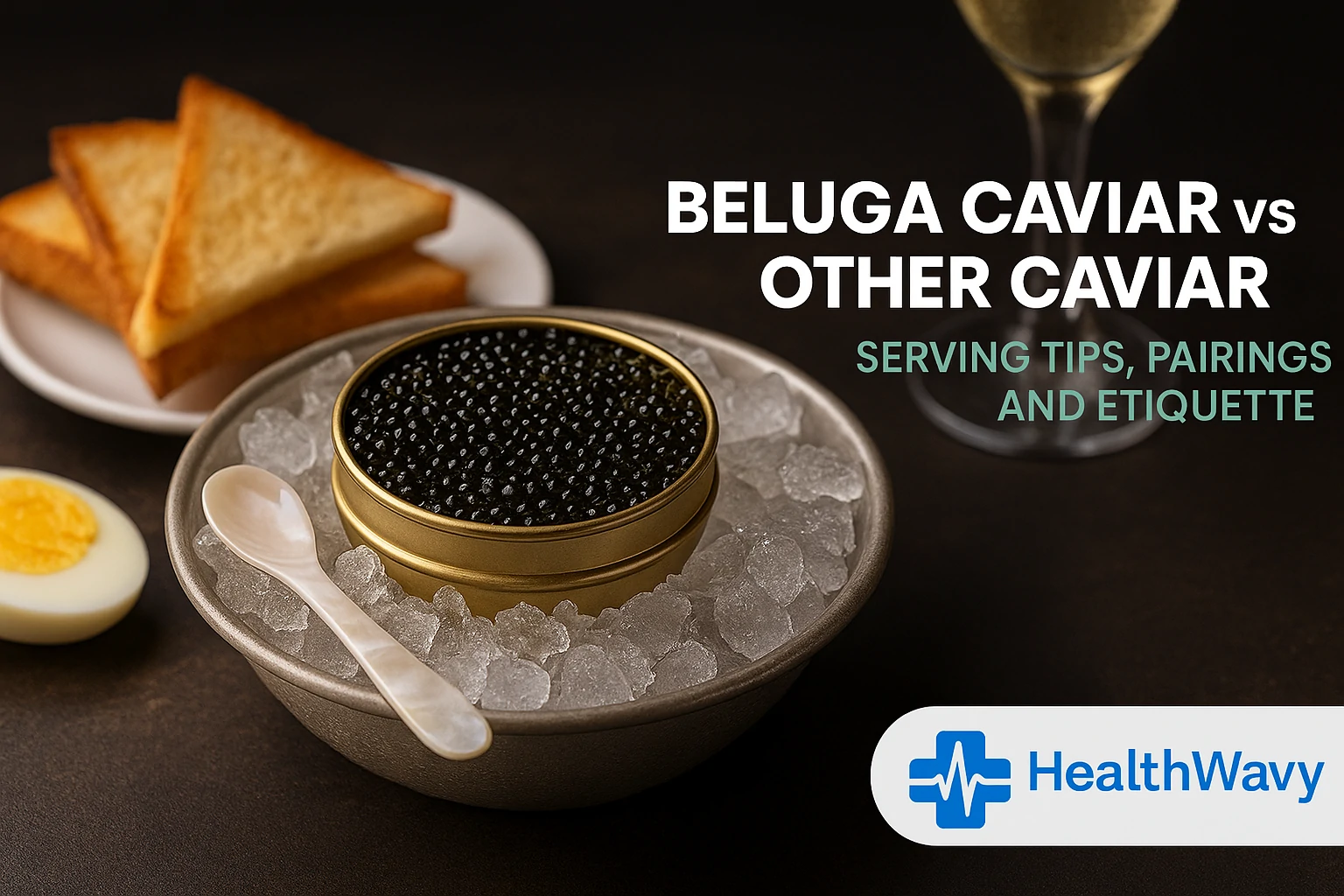
Caviar tastes best when served cold. Keep the tin on crushed ice. Use a spoon made of pearl, plastic, or bone. Avoid metal spoons. Metal can change the taste.
Serve with simple foods. Toast points, blini, and soft-boiled eggs work well. Crackers with no added salt also help. Do not add lemon, vinegar, or raw onions. These will hide the flavor.
Good drinks include:
- Dry champagne
- Chilled vodka
- Cold still water
Keep portions small. Let each guest taste it alone before adding anything else. Do not mix caviar into dips or sauces. That takes away from its clean texture and gentle pop.
Endangered Status, Farm Rules, and Ethics
The beluga sturgeon is endangered. It faces threats from dam building, overfishing, and pollution. In the wild, the species is close to collapse. U.S. law bans imports of wild-caught beluga to help protect it.
One legal farm in Florida raises beluga sturgeon in closed systems. The water is clean and the fish are not exposed to outside harm. The farm follows strict rules under U.S. wildlife laws. It produces legal, safe beluga roe.
Ethical buying means choosing farm-raised products. It means avoiding vague sellers who do not list the source. It also means asking questions before you buy. Good farms want to protect the fish and still give you high-quality food.
Fraud, Mislabeling, and How to Spot Fakes
Fake caviar appears often online. Some sellers use misleading labels. They say “Caspian caviar” or “premium black roe” but do not name the fish. Others offer very low prices to attract buyers.
Common red flags include:
- No species name on the label
- No batch code or farm info
- Claims of “wild” or “imported from Russia”
- Tins that arrive warm or unsealed
- No returns or shipping policy
Real beluga caviar in the U.S. must list “Huso huso” and come from a licensed domestic farm. Always check the shipping method. If the tin arrives without ice or tracking, do not eat it. Return it or ask for a refund.
Pregnancy and Health Safety Guide
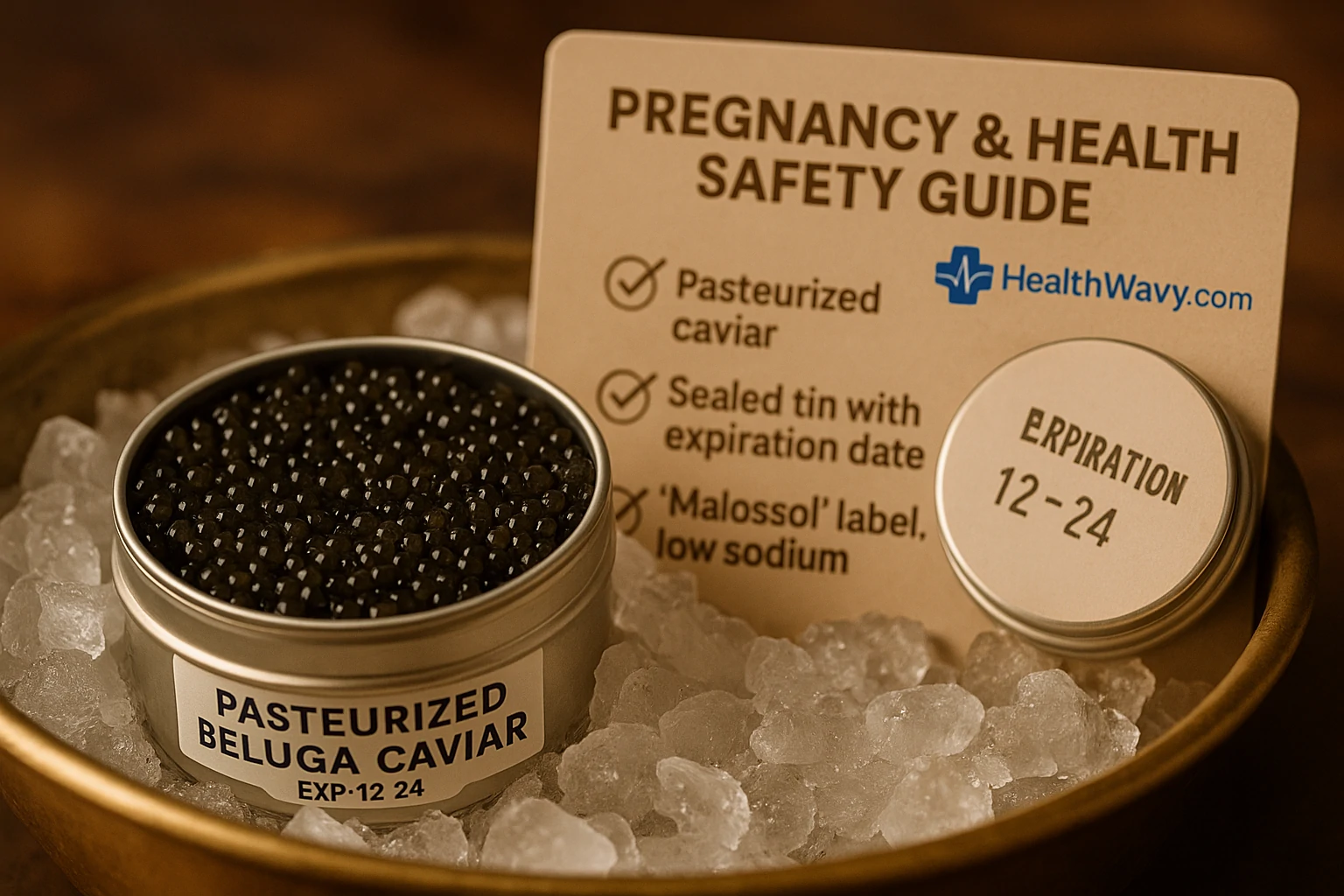
Pregnant people should avoid raw caviar. It may carry Listeria, a bacteria that can harm unborn babies. Pasteurized caviar is a safer choice. Make sure it comes in a sealed tin with a clear expiration date.
Keep the tin cold at all times. Do not eat caviar that smells odd or feels slimy. Talk to your doctor before trying any raw food during pregnancy. Some people may need to avoid it entirely.
Also watch salt levels. Caviar has more sodium than many snacks. People with heart or kidney issues should eat only a small amount.
Sodium Facts, Portions, and Label Tips
Caviar gets its taste from salt. But too much salt is not safe for some people. A tablespoon of beluga caviar can have up to 400 mg of sodium. That is about one-fifth of the daily limit for healthy adults.
Keep your serving small. Use a teaspoon, not a soup spoon. Let the flavor speak for itself. One or two bites often feel like enough.
Look at the label. You should see the word “malossol.” This means the caviar has low salt. Also check the storage instructions and pack date. Never buy tins with no details or unclear print.
From Sturgeon to Tin, Step-by-Step
Making beluga caviar takes time and care. Farms raise sturgeon in freshwater tanks. The fish grow slowly. Some take 15 years or more before they produce eggs.
Once the fish matures, the farm checks it with an ultrasound scan. If the roe is ready, the farm harvests it under clean conditions. The eggs are then washed, sorted, and lightly salted. Each tin is sealed, labeled, and packed cold.
The whole process must follow U.S. safety laws. No step can be rushed. Real beluga caviar takes years to make but only seconds to enjoy.
Best Alternatives That Stay Legal and Sustainable
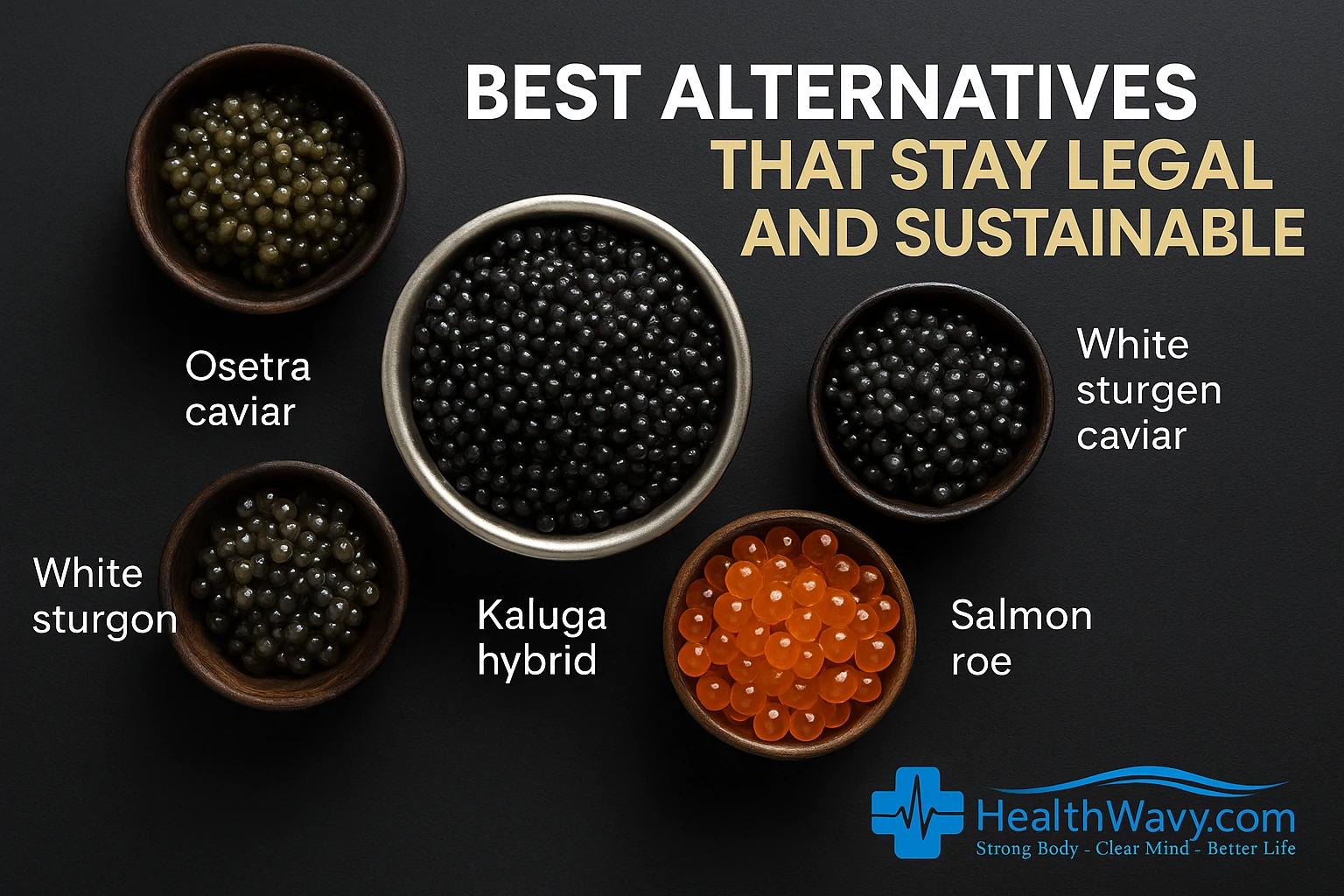
Beluga caviar is rare and expensive. Many people look for options that taste similar but stay within budget. Others want legal, eco-friendly products. Good news: there are smart alternatives that meet these needs.
Kaluga hybrid caviar is the closest in taste and size. It comes from a cross between Huso dauricus and Amur sturgeon. These eggs look large and feel smooth. The flavor is rich and clean. It offers a similar texture at a lower price. Most Kaluga caviar is legal and farm-raised.
Osetra caviar brings a nutty flavor and medium pearls. It costs less than beluga but still feels refined. It works well for tastings and gifts.
White sturgeon caviar is common in the U.S. It comes from farms in California. The pearls are medium to large. The flavor is buttery and mild. This type offers clear traceability and fair pricing.
Paddlefish roe is not true caviar, but it gives a salty, earthy taste. It works well on toast or eggs. It is legal, local, and much more affordable.
Salmon roe gives big orange pearls and bold flavor. It costs less and adds color to any plate. Use it when hosting large groups.
Price Guide, Grades, and What Sets Quality
Beluga caviar is one of the most expensive foods you can buy. Prices vary based on grade, source, and freshness. Most legal tins in the U.S. cost between $200 and $500 per ounce.
Grades depend on:
- Egg size
- Color
- Texture
- Shine
- Salt level
- Freshness
Premium grade beluga has large, even pearls. The color ranges from light gray to jet black. The texture feels smooth and firm. The flavor should be clean, not fishy or too salty.
Mid-tier grade may have smaller eggs or a less glossy finish. It still offers good taste but may lack the soft pop or delicate balance of premium tins.
Always ask the seller what grade they offer. Some may provide a sample before large orders.
Storage, Shelf Life, and Freshness Signs
Caviar spoils fast if not stored right. Always treat it like raw seafood. The coldest part of your fridge is the best place to keep it. Ideal temperature: 28-32°F.
Shelf life:
- Unopened pasteurized tin: 2 to 4 weeks
- Unopened raw tin: 1 to 2 weeks
- Opened tin (any type): Eat within 24-48 hours
Fresh caviar looks and smells clean. Signs of spoilage include:
- Sour or strong fishy smell
- Cloudy liquid inside the tin
- Bulging lid
- Slimy or dry texture
- Discoloration
Do not taste it if anything feels off. Safe caviar should glisten, pop softly, and have no harsh odor.
If you enjoy exploring unique seafood with health value, read our full feature on What Is Calamariere? Health Benefits, Risks, and How to Eat It.
Home Serving Guide for First-Time Buyers
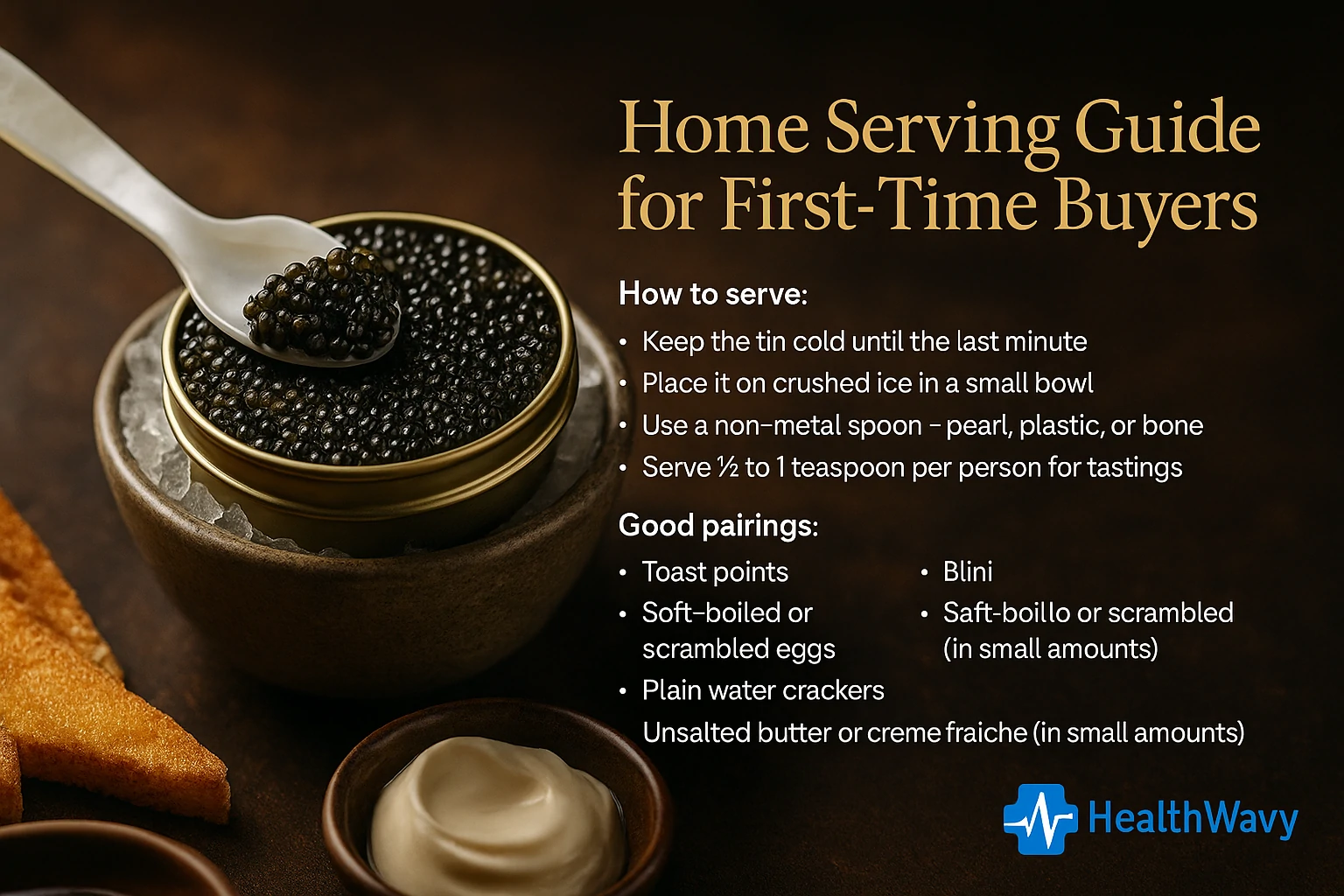
Serving caviar at home can feel fancy but is easy with a few steps. You don’t need a chef or luxury tools.
How to serve:
- Keep the tin cold until the last minute
- Place it on crushed ice in a small bowl
- Use a non-metal spoon – pearl, plastic, or bone
- Serve ½ to 1 teaspoon per person for tastings
Good pairings:
- Toast points
- Blini (small Russian pancakes)
- Soft-boiled or scrambled eggs
- Plain water crackers
- Unsalted butter or crème fraîche (in small amounts)
Drink options:
- Dry champagne
- Chilled vodka
- Sparkling water
Make sure guests taste it plain first. Let the texture and flavor shine. Keep everything simple and cold.
Restaurant Ordering Guide Without Regrets
Ordering caviar at a restaurant can be tricky. The prices are high, and menus may not explain much. Ask questions to avoid bad choices.
What to ask:
- What species is this caviar from?
- Is it pasteurized or raw?
- Where does the supplier get it?
- Is it from a U.S. farm or imported legally?
A good restaurant will give honest answers. If they say “it’s wild Caspian,” do not order it. That likely breaks U.S. law.
Make sure the caviar comes cold, on ice, and with proper spoons. If it looks dry or warm, send it back. High price should match high care.
Myths, Facts, and Expert Advice About Beluga Caviar
Myth 1: All black caviar is beluga.
Fact: Many sturgeon species make black caviar. Only “Huso huso” gives true beluga.
Myth 2: More salt means better flavor.
Fact: Too much salt hides flavor. “Malossol” tins use less salt to preserve the natural taste.
Myth 3: Beluga caviar comes fresh from the sea.
Fact: All legal beluga caviar in the U.S. comes from licensed farms.
Myth 4: You must be rich to try caviar.
Fact: Small tins and legal alternatives make it possible for most people to try it once.
Expert tip: Always check the species, batch code, and storage method. These three signs protect both your money and your health.
Beluga Caviar U.S. Ban, Florida Farm Exemption, and Buyer Rules
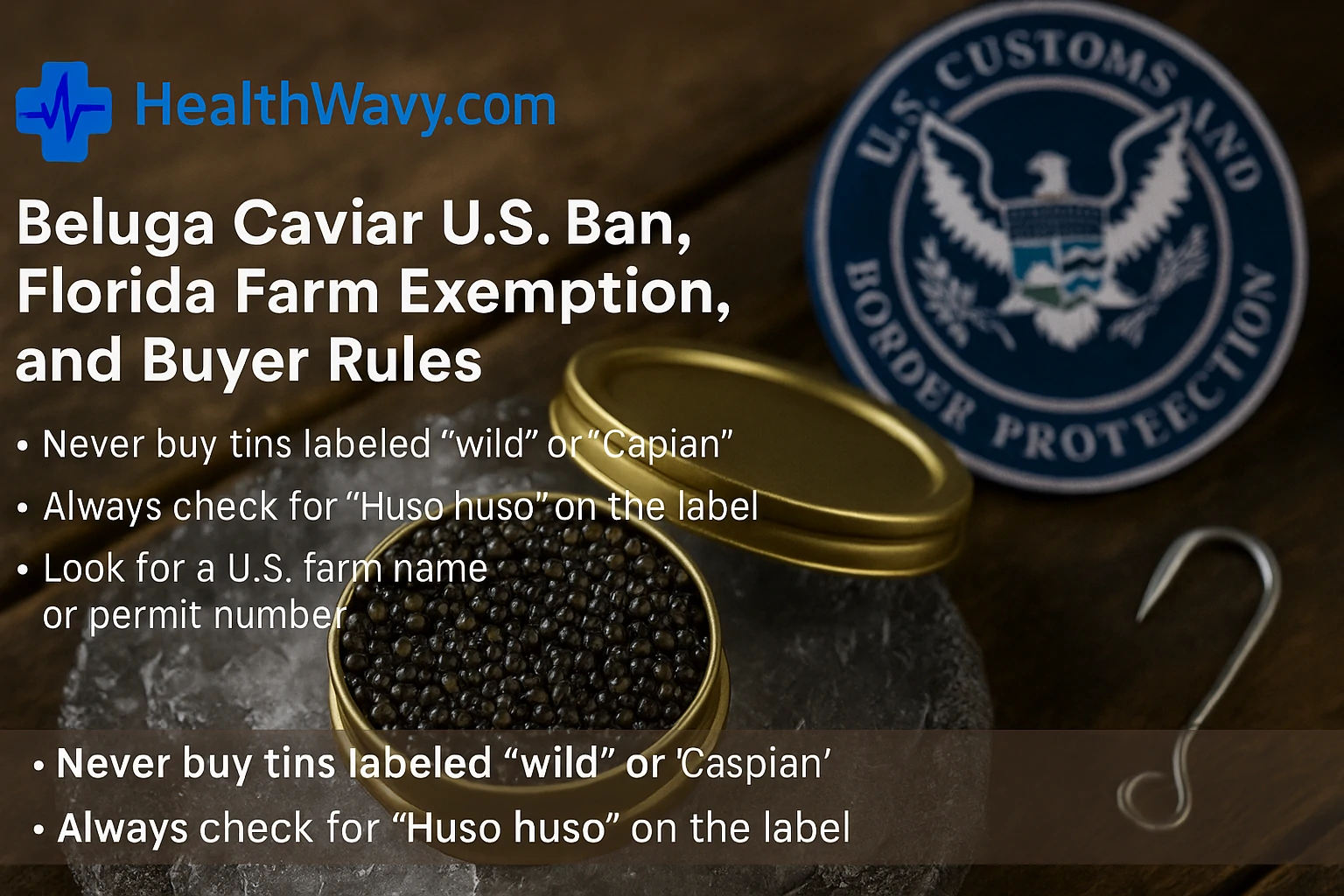
Since 2005, the U.S. has banned all wild beluga caviar imports. The reason is simple: the beluga sturgeon faces extinction. This rule comes from the Endangered Species Act.
One farm in Florida got a special permit to raise beluga legally. It uses tanks with clean water and follows strict controls. This farm is the only legal source of beluga caviar in the U.S.
What buyers must know:
- Never buy tins labeled “wild” or “Caspian”
- Always check for “Huso huso” on the label
- Look for a U.S. farm name or permit number
- Ask about shipping method and storage
Buying illegal caviar puts you at risk of fines or worse. Stick with licensed sellers.
Complete Glossary of Terms and Labels
Huso huso – The beluga sturgeon species
Malossol – Russian for “low salt”; best grade of caviar
Batch code – ID number that links the tin to its source
Pasteurized – Lightly heated to extend shelf life
Hybrid – Cross between two sturgeon species
Kaluga – Huso dauricus, close to beluga in size and taste
Osetra – Russian sturgeon with nutty taste
Sevruga – Smallest eggs, sharp and salty
Roe – Fish eggs, not always from sturgeon
Cold chain – Temperature control from farm to fridge
Taste Notes, Texture Maps, and Pairing Ideas
Beluga caviar offers a soft and refined flavor. It does not shout. It whispers. The taste starts clean and ends with a creamy finish. Each pearl gives a gentle pop. There is no harsh salt, no sharp aftertaste. The texture is smooth, not mushy.
Taste notes include:
- Cream
- Butter
- Light sea air
- Subtle nut hint (in older fish)
Texture map:
- Outer shell: thin but firm
- Bite: soft, not sticky
- Pop: light and even
- Finish: clean and mild
Top pairings:
- Dry champagne (adds lift)
- Chilled vodka (clears the palate)
- Blini with unsalted butter
- Soft-boiled eggs
- Cold still water
Avoid onions, lemon, sour cream, or flavored crackers. These overpower the roe.
Safe Shipping, Cold Chain, and Return Policies
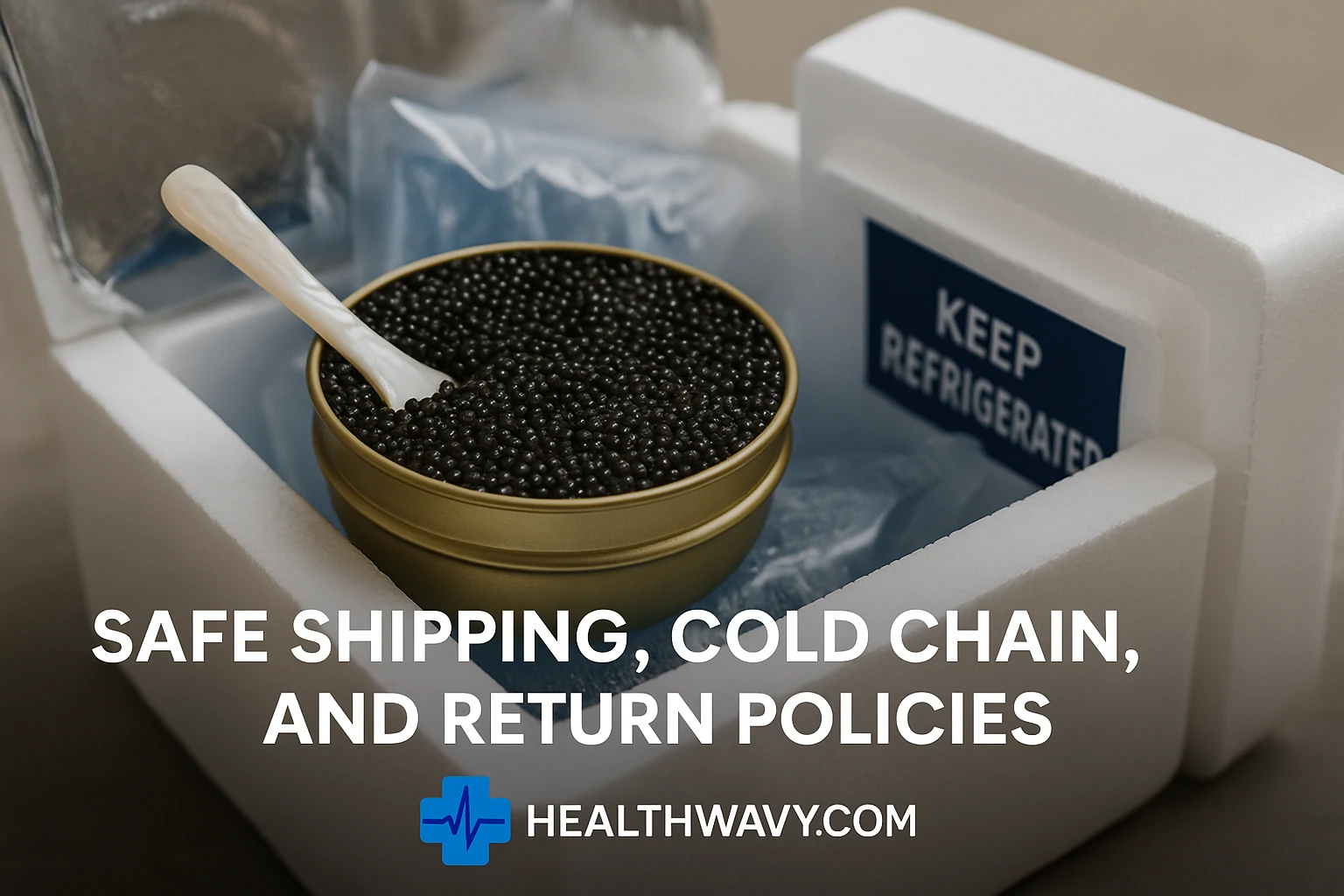
Caviar is fragile. It cannot handle heat or delays. Each tin must stay cold from the moment it leaves the farm until it reaches your hands. This cold chain protects the texture, flavor, and safety of the eggs.
A good seller uses fast shipping. The best method is overnight air. The package should come in a sealed, insulated box. Inside, you should find cold gel packs or dry ice. The tin must stay chilled during the whole trip.
The outside of the box should include a clear label. It should say “Keep Refrigerated” in large print. You may also get a tracking number to follow the shipment.
When the box arrives, open it right away. Touch the tin. It should feel cold. If it feels warm or soft, do not taste it. If the box leaks or the tin looks damaged, take photos. Contact the seller without delay.
A trusted seller will stand behind their product. They should offer a full refund for spoiled tins. You should not need to wait days to hear back. The return process should be simple and fair. Clear contact details must appear on the website or invoice.
Do not buy from stores that ignore these steps. If a seller cannot explain how they ship or handle returns, choose another one. Real caviar costs too much to take that risk.
Eco Impact, Certifications, and Traceability
Beluga caviar can be safe for the planet. It depends on how and where the farm raises the fish. A good farm avoids harm to nature. It uses clean systems and follows strong rules.
Wild sturgeon face danger from overfishing and pollution. Legal farms help protect the species. These farms do not catch fish from rivers or seas. They raise them in tanks with filtered water. The water stays clean, and the waste stays low. Farmers control feed, light, and care. This makes the process safer for both fish and people.
A trusted seller offers proof. Look for permits from U.S. Fish and Wildlife. You may also see CITES documents. These protect rare animals across borders. A U.S. farm may also follow FDA food rules. Some offer lab results to show the eggs are safe.
Real caviar has a clear trail. A good tin shows the batch code and the farm name. Some include a pack date or scan code. This helps you trace the product from fish to tin. You know where it came from and how it got to you.
Ask the seller if they can show records. They should not hide the farm or the process. If they refuse, pick a different source. Good sellers stand behind what they sell.
Tin Sizes, Serving Ware, and Table Setup
Beluga caviar comes in different tin sizes. Each size fits a different need. Small tins work for tasting. Large tins work for events.
A 30g tin (about 1 ounce) serves two or three people. A 50g tin serves four to six. A 125g tin can serve eight to twelve guests. The more people at the table, the larger the tin you need.
Use proper tools to serve it right. Metal spoons damage flavor. Pick pearl, plastic, or horn. Place the tin on a small bowl of crushed ice. Keep extra napkins near the dish. Add a plate for blini, toast, or crackers.
Keep the setup clean. Do not add bright sauces or bold toppings. Avoid onions, lemon, or flavored spreads. Let the caviar lead. It should stay cold and center stage.
Offer each guest a spoon. Let them take small tastes. Start with a toast. Keep the mood light and the bites small. A simple table brings out the best in each pearl.
Storage Mistakes and Fast Fixes
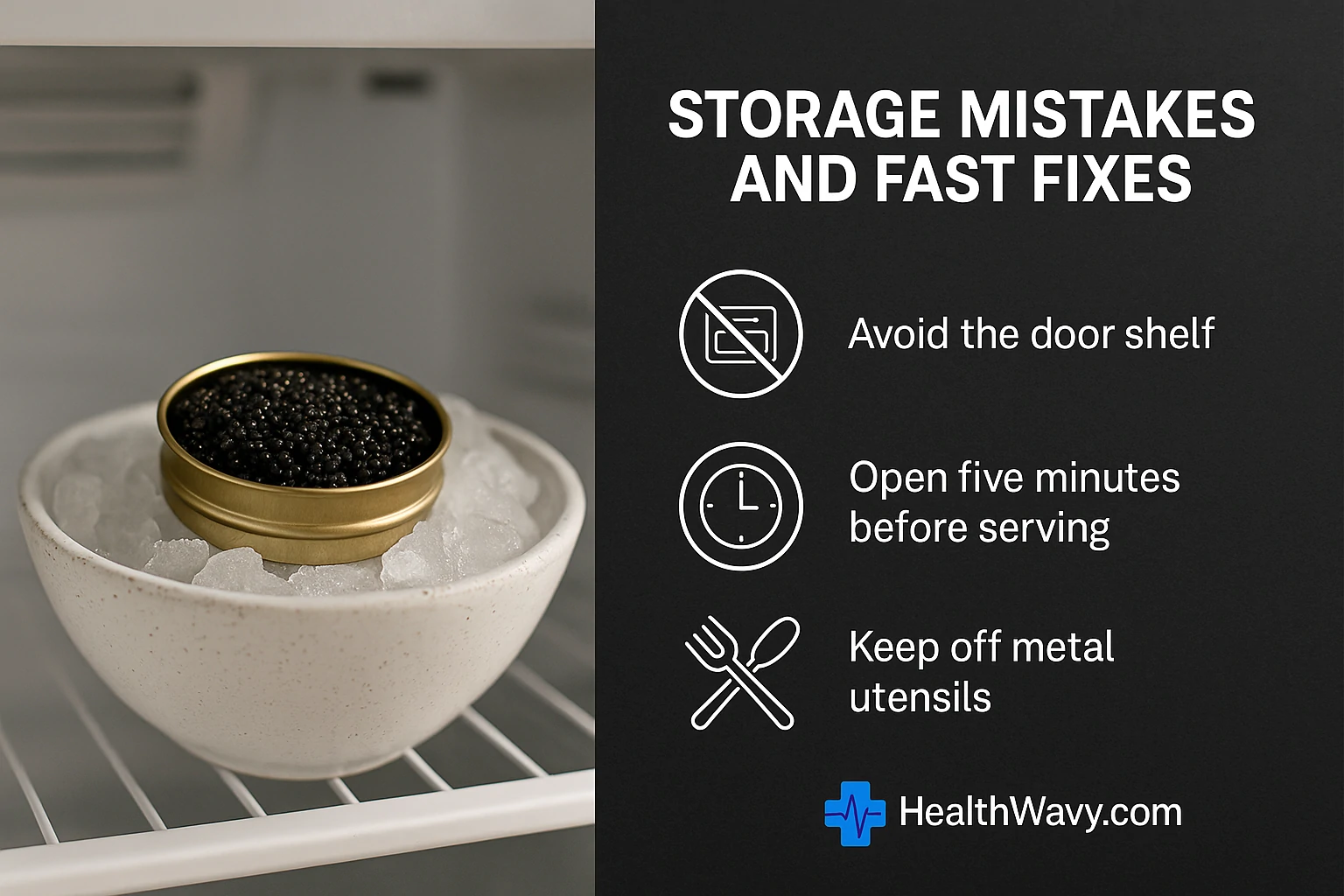
Caviar spoils fast if you store it wrong. Many people make simple mistakes that ruin the tin. One bad step can waste the entire product.
Some place the tin in the fridge door. That part is too warm. Move it to the back where it stays coldest.
Others open the tin too early. Wait until five minutes before serving. This keeps the texture fresh.
Some leave the tin out during the meal. Always keep it on ice. Even a few minutes at room temperature can dull the flavor.
Some use metal spoons. Metal adds a bad taste. Use pearl or plastic only.
Others freeze the tin to make it last longer. Never freeze caviar. The eggs crack and turn soft. If you already froze it, do not eat it.
Handle each tin with care. A small slip can turn luxury into waste. Follow each step, and your caviar will stay fresh, smooth, and safe to enjoy.
Beluga Caviar: Buyer Checklist You Can Trust
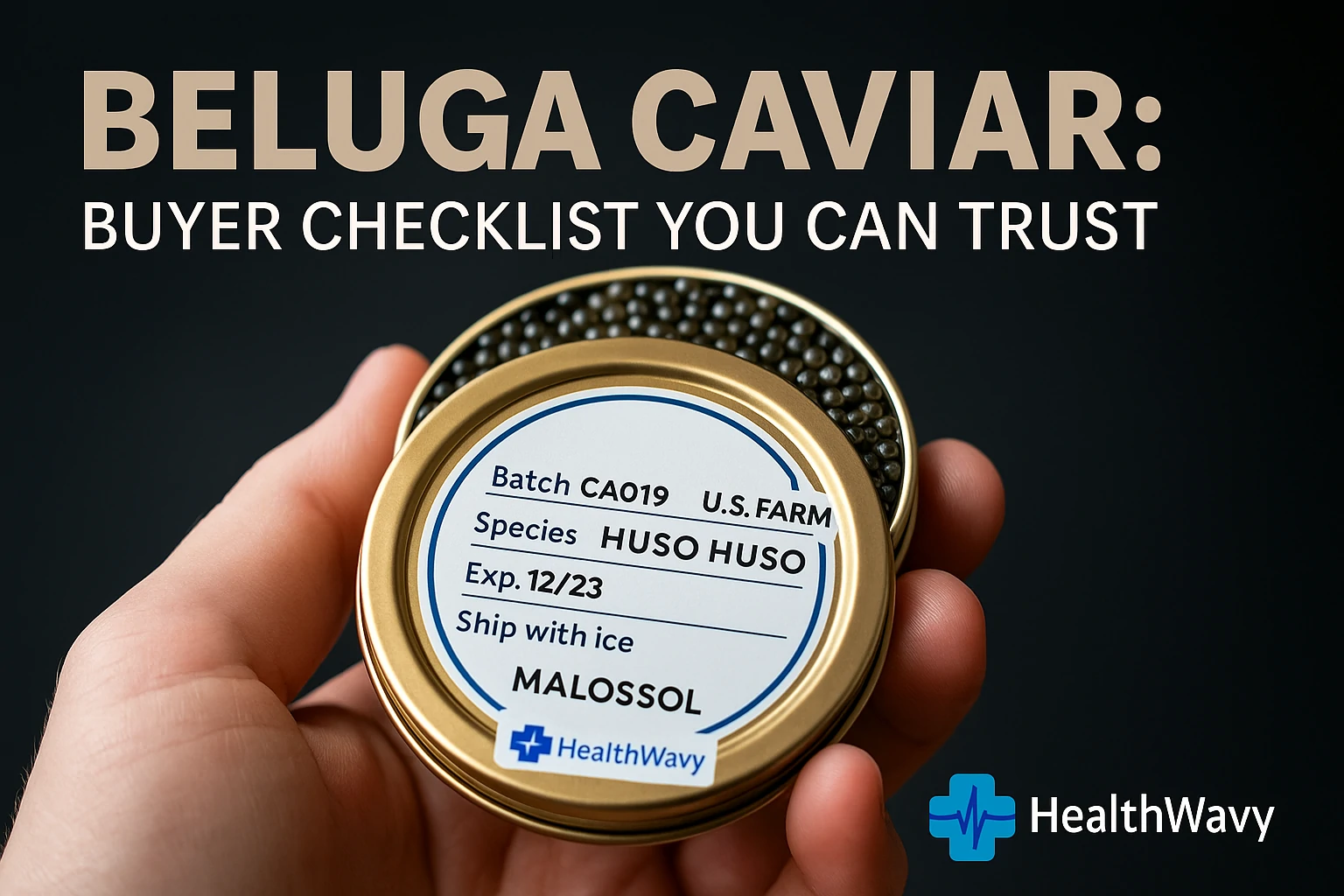
Smart buying starts with the label. A good tin tells you everything. A bad one hides the truth. Before you buy, check each detail. Take your time. Trust the facts.
The species must say Huso huso. This name proves it is real beluga caviar. If the label uses only phrases like “black caviar,” skip it.
A U.S. farm or legal seller must be listed. The farm must follow U.S. wildlife rules. Imported or “wild” tins break the law.
Look for a batch code. This number links the tin to its source. If the code is missing or smudged, it’s a red flag.
The seller must ship the caviar cold. Ice packs or dry ice must be in the box. Next-day air is the best option.
Check the return policy. You need a clear way to contact the seller if something goes wrong. They should offer a refund if the tin arrives warm or damaged.
Make sure the pack date or expiration date appears on the label. This helps you track freshness.
The word malossol should also appear. This means the caviar has low salt. Low salt gives better taste and keeps the texture soft.
Avoid sellers who use flashy terms like “wild Caspian” or “imported from Russia.” These claims often signal fake or illegal goods.
If any one of these signs is missing, do not buy. A real seller has nothing to hide.
Pravi Celer Benefits Backed by Science: A Simple Wellness Guide
State Rules, Shipping Limits, and Age Laws
Beluga caviar is food, not alcohol. You do not need to meet an age limit to buy it. Still, laws in the U.S. may differ by state. Some states block certain fish products. Others set rules for food handling and delivery.
The safest way to buy beluga caviar is through a licensed U.S. seller. Do not order from foreign sites or sellers who cannot ship legally across state lines. Always check if the company can ship to your zip code.
Pick overnight shipping when possible. The seller should pack the caviar in an insulated box with ice or dry ice. If they offer only slow delivery or ground mail, choose another source.
Some shipping services (like FedEx) allow food with dry ice. Others limit what can ship with temperature control. Read all the details before you order.
Ask about return options before you pay. Good sellers explain how to report problems, request a refund, or send back spoiled tins. If they offer no policy or avoid your questions, walk away.
Buying caviar should feel safe. The law protects you when the seller does things right. Stick with those who follow the rules.
Expert Picks at Different Budgets
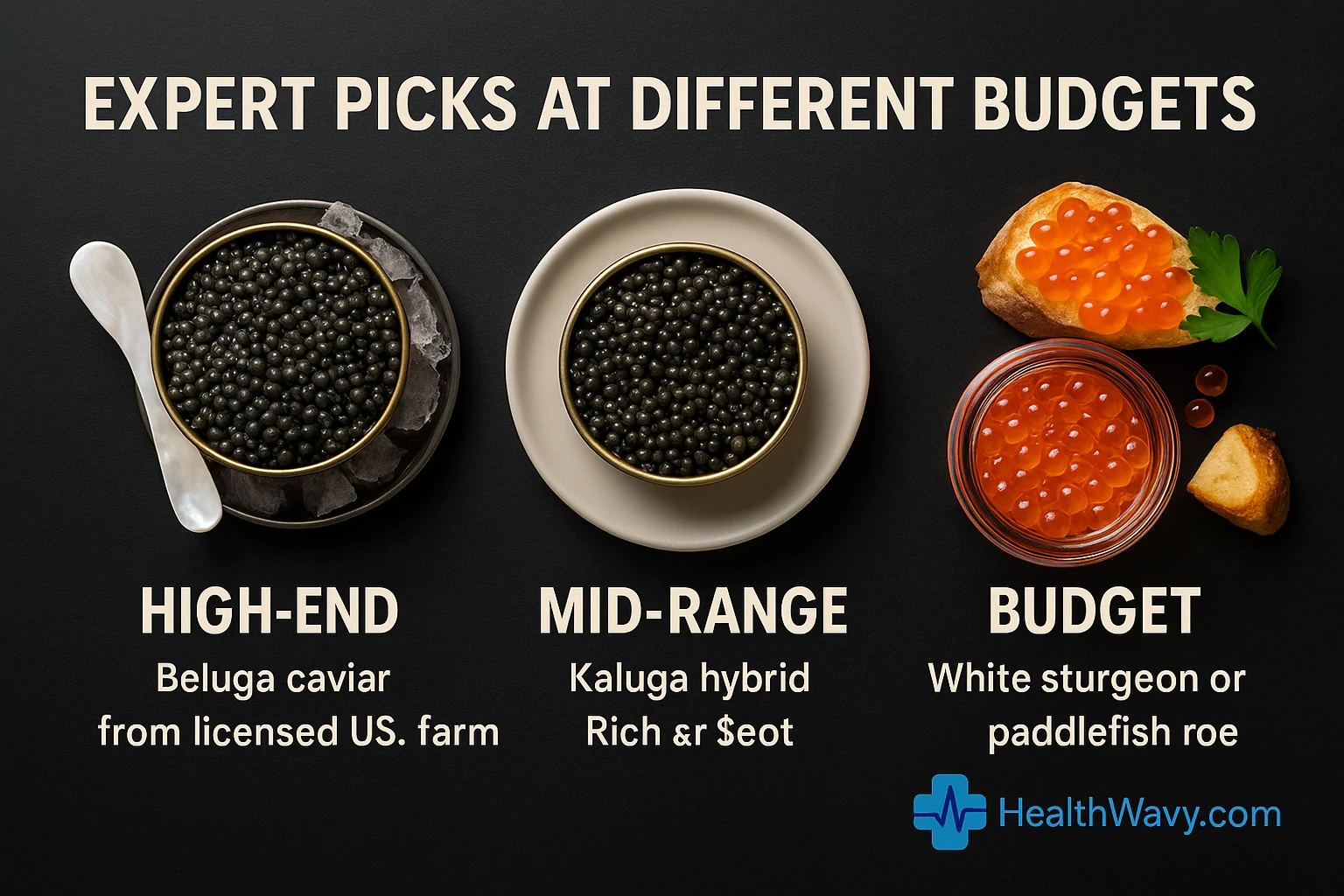
Not every tin costs the same. You do not need to spend $500 to enjoy fine roe. You just need to know what to buy at each level.
High-End Pick
Buy true beluga caviar from a licensed U.S. farm. Expect large pearls, smooth texture, and a clean finish. This is best for special events or high-end gifts. Price: $400 to $500 per ounce.
Mid-Range Pick
Choose Kaluga hybrid caviar. The taste is close to beluga, and the pearls feel rich and soft. These farms follow strong rules and produce top-grade roe. Price: $150 to $300 per ounce.
Budget Pick
Go with white sturgeon or paddlefish roe. These offer mild, earthy flavors. You can serve them on toast or with soft eggs. Great for first-time buyers. Price: $50 to $100 per ounce.
Bonus Option
Try salmon roe. The pearls are bright and large. The flavor is bold. It works well in casual meals and adds color to the table.
Pick what fits the moment. Not every guest needs beluga. A well-served alternative still makes the meal feel special.
Home Taste Test Guide and Score Cards
A tasting lets you compare different caviar types at home. You do not need a large party. Two or three people is enough.
Start with three kinds of roe. Beluga, Kaluga, and Osetra make a strong trio. Buy small tins of each. Keep them sealed and cold until it’s time to eat.
Set up a clean table. Use crushed ice, pearl spoons, and small plates. Give each guest a blank score card. Ask them to rate each sample.
Focus on five things:
- Egg size
- Texture
- Salt level
- Flavor finish
- Overall feel
Do not tell guests which tin is which. Label them A, B, and C. Serve a small taste of each. Let everyone write their scores.
After the tasting, reveal the names. Talk about the scores. You may learn that price does not always equal taste.
Safe Gift Guide for Holidays and Events
Caviar makes a bold and thoughtful gift. It feels rare and personal. But sending it wrong can spoil the whole idea. A good gift starts with care and ends with smart delivery.
Pick a pasteurized tin if you plan to ship. Pasteurized roe handles travel better. It can stay cold longer and holds up to slight changes in temperature. Raw tins may not survive the trip unless packed under strict cold chain.
Include a non-metal spoon in the box. Choose pearl or plastic. Add a simple note with tips: “Keep chilled. Serve cold. Use within 48 hours.” A short message makes the gift feel warmer.
Always choose overnight delivery. Use a seller that ships with dry ice or gel packs. The package must stay cold from door to door. Check if the seller guarantees safe arrival.
Avoid sending raw caviar to places without reliable cold storage. If you cannot confirm the setup at the other end, stick to pasteurized tins.
A smart gift does more than impress. It shows you know the product, respect the care it takes, and value the person who receives it.
Science of Flavor, Salt, and Texture
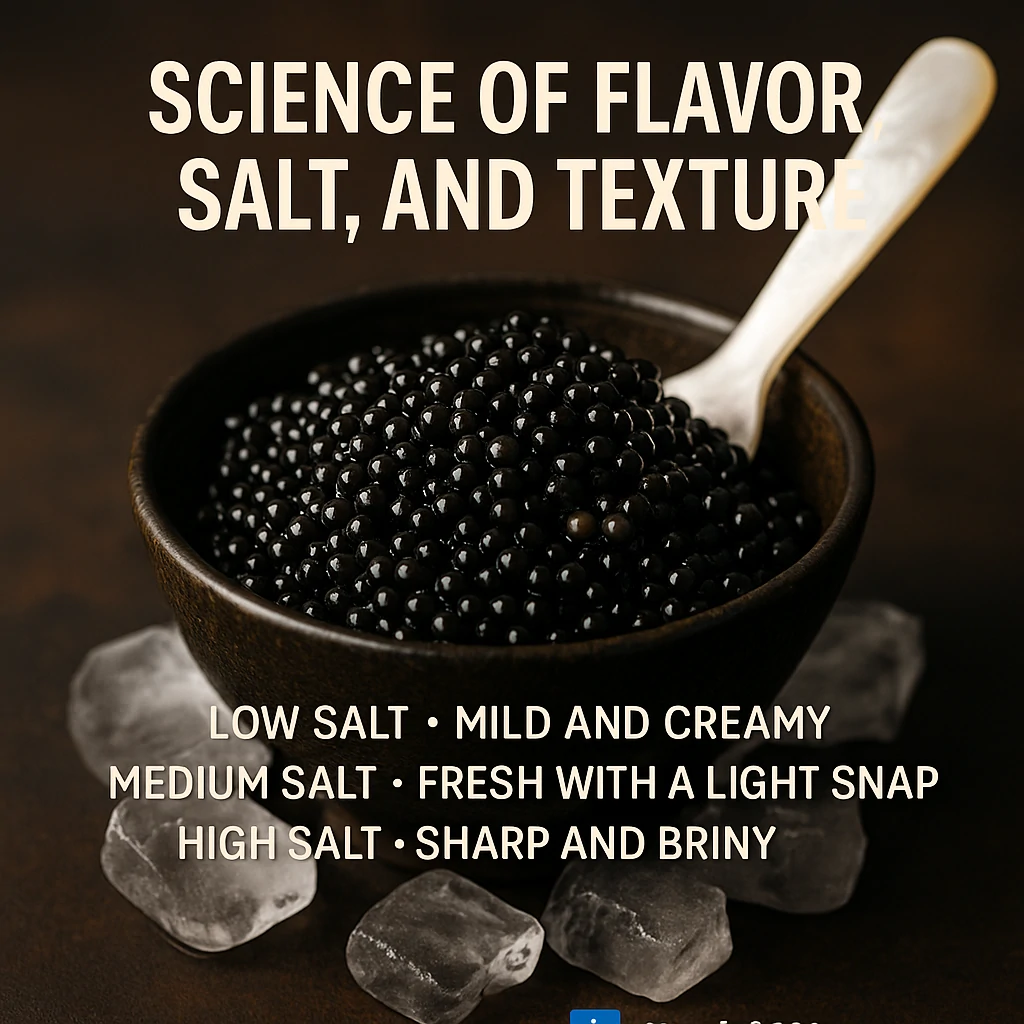
Beluga caviar tastes clean and soft. This comes from a mix of fats, proteins, and trace minerals. These come from the fish and the clean water it lives in. Each part of the process shapes the final flavor.
Salt plays a big role. It does more than preserve. It unlocks the natural taste of the roe. But too much salt can ruin the smooth finish.
Low salt brings a mild, creamy feel. It lets the real flavor shine.
Medium salt keeps the eggs fresh longer and adds a light snap.
High salt gives a sharp, briny taste and dulls the soft edge.
Texture depends on the age of the fish. Young fish produce tender pearls. Older fish give thicker shells. Both have value, but they feel different in the mouth. Some people like the clean pop. Others prefer a more delicate bite.
Farm conditions also affect the outcome. Water quality, feed, and care all shape the final product. That’s why legal farms track every step.
Caviar must stay cold. The best range is 28 to 32 degrees Fahrenheit. A warm tin loses its texture fast. Soft roe means trouble.
If the caviar feels firm, glossy, and cool, you are in for a good experience.
Heritage, Culture, and Modern Farms
Caviar once traveled by river and horse. It sat on royal tables. Today, it travels by plane and cold box. It sits in home kitchens and modern cafes.
The culture has changed, but the soul stays. Each pearl holds history. From the Caspian Sea to U.S. tanks, the journey continues.
Modern farms use tech, but the goal is the same: clean, rich food with deep roots.
Risks to Avoid and Red Flags
Avoid these risks:
- Buying from unknown sellers
- No species or batch code
- Claims of “wild” or “imported”
- Cheap prices under $100
- No return policy
- Warm delivery boxes
- Fishy smell on opening
Trust your senses. Good caviar looks clean, smells mild, and feels smooth.
The Full Handbook for U.S. Readers
You now have the full guide to beluga caviar in the United States. You know the legal facts. You know how to buy, store, and serve it. You know what to ask, what to avoid, and what to enjoy.
Beluga caviar is rare, rich, and deeply rooted in food history. The law protects the fish. You can enjoy the flavor without harm. Choose licensed farms. Keep the tin cold. Use small bites. Share with care.
You don’t need to be a chef or a collector. You just need the facts. This guide gives them to you-clear, safe, and honest.
Common Questions with Clear Answers
Is beluga caviar legal in the U.S.?
Yes, but only if it comes from a licensed U.S. farm.
Can pregnant people eat it?
Yes, if it is pasteurized and comes in a sealed tin.
How long does caviar last?
Unopened: 2-4 weeks. Opened: 1-2 days.
Why is it so expensive?
The fish grows slow, the process is careful, and the supply is small.
How do I know it’s real?
Look for “Huso huso,” a batch code, and a U.S. farm name.
Can I freeze leftover caviar?
No. Freezing ruins the texture.
What if my tin smells odd?
Do not taste it. Contact the seller for a refund.
Conclusion
Beluga caviar offers more than flavor. It brings together time, patience, and craft. Each tin tells a story that begins in clean water and ends with a soft pop on your tongue.
This food is rare. It is also protected. In the U.S., only a few farms may produce it. The law keeps the species safe. Your role is to buy with care and serve with pride.
You now know what matters. You know the legal signs. You know how to store, ship, and taste it. You know what to ask before you buy. You can tell real from fake. You can serve it with confidence.
A good tin of caviar feels like a reward. You don’t need much. Just a cold spoon, a quiet moment, and the right people at your table.
Use this guide each time you shop or serve. Trust what you know. Taste what you love. Let each spoon speak for itself.
To explore another natural product that supports daily wellness, see our guide on Insoya Health Guide: Benefits, Fitness Use, Wellness Impact, and Daily Tips.
Disclaimer: This guide shares general information about beluga caviar for educational purposes. It does not replace legal or medical advice. Always check U.S. regulations and consult a qualified expert before making health or purchase decisions.
Note: Information in this article is for awareness only. Laws, prices, and safety rules may change. Always verify with trusted sources before buying or consuming caviar.

